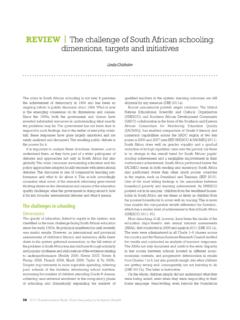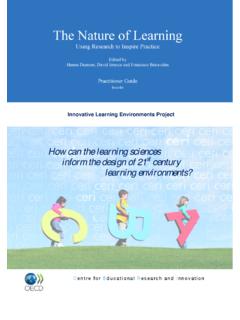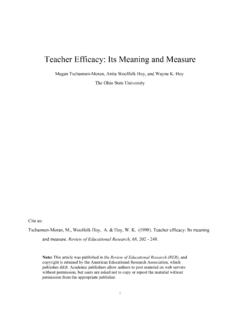Transcription of Vygotsky’s Zone of Proximal Development Theory: …
1 GJSS ISSN: 2276-7800 Impact Factor 2012 (UJRI): ICV 2012: Vygotsky s Zone of Proximal Development Theory: What are its Implications for Mathematical Teaching? By Denhere Christmas Chinyoka Kudzai Mambeu Josiah Greener Journal of Social Sciences ISSN: 2276-7800 Vol. 3 (7), pp. 371-377, August 2013 371 Research Article Vygotsky s Zone of Proximal Development Theory: What are its Implications for Mathematical Teaching? Denhere Christmas, *Chinyoka Kudzai and Mambeu Josiah Department of Educational Foundations, Great Zimbabwe University. *Corresponding Author s Email: ABSTRACT This article focused on Vygotskian Zone of Proximal Development and its implications to the teaching of Mathematics in the schools.
2 Literature has shown that underachievement and poor performance characterise the learning of Mathematics. Teaching Mathematics in the child s zone of Proximal Development is viewed as one way of improving performance in Mathematics. Literature argues that teaching in the Zone of Proximal Development where the child s learning is mediated and scaffolded by the teacher or expert adult or knowledgeable peer makes learning more meaningful, easier, manageable, effective and efficient. The major challenge that the theory presents to teachers is that it is difficult to identify every learner s zone of Proximal Development . Despite this limitation, the ZPD if appropriately applied could improve Mathematics teaching and learning in the schools. Keywords: Zone of Proximal Development , scaffolding, mediation, interaction and socio-cultural.
3 INTRODUCTION Worldwide, performance in Mathematics by students has persistently been poor (Mbugua, Kibet, Muthaaa & Nkonke, 2012). Research suggests that the application of Vygotsky s theory of the Zone of Proximal Development (ZPD) could improve mathematical achievement (Roosevelt, 2008). It is argued that the theoretical significance of the ZPD is that it enables penetration into the causal-dynamic and genetic connections determining the process of mental Development (Chaiklin 2003; Cole 2000; Obukhova, & Korepanova, 2009). The article discusses the relevance and implications of the ZPD theory to the teaching of Mathematics. THE ZONE OF Proximal Development (ZPD) Vygotsky conceives of the zone of Proximal Development as central to instructional enhancement and classroom change in Mathematics. According to Vygotsky, the zone of Proximal Development is the distance between the actual Development level as determined by independent problem solving and the level of potential Development as determined through problem solving under adult guidance or collaboration of more capable peers (Murray, & Arroyo, 2002).
4 Vygotsky (1978) opined that the ZPD is the current or actual level of Development of the learner and the next level attainable through the use of mediating semiotic and environmental tools and capable adult or peer facilitation. In other words, it is what a child can do alone at a particular point in time. The second, "potential Development " is defined as that which a child can achieve if given the benefit of support during the task. It is the ability to solve problems "under adult guidance or in collaboration with more capable peers. Greener Journal of Social Sciences ISSN: 2276-7800 Vol. 3 (7), pp. 371-377, August 2013 372 Figure 1: A Model of the Zone of Proximal Development . Adapted from ( ) Explanation of the diagram: The yellow colour is the zone of achieved Development (ZAD).
5 The ZAD indicates that the child has mastered the mathematical concepts and can independently perform them without assistance. The purple area is referred to as the ZPD where learning can proceed with the assistance of an expert. This is an active learning zone. The blue colour denotes the area in which even with the assistance of an expert, the child will not learn. The Zone of Proximal Development (ZPD) indicates the functions that have not yet matured but are in the process of maturation. Rogoff (1990) points out that the ZPD is a dynamic region of sensitivity to learning the skills of culture, in which children develop through participation in problem solving with more experienced members of a group. Cole (2001) in turn argues that within the ZPD, culture and cognition create each other. The ZPD is critical for Mathematics learning and instruction because it determines the level of work to be taught which is desirable to the child.
6 Vygotsky suggested that teaching geared to developmental levels that have already been achieved will be ineffective, and that "the only 'good learning' is that in advance of Development (Kearsley, 2005; Scherba de Valenzuela, 2002). The "effective ZPD" is defined by the difficulty of mathematical tasks possible if the student is given the available help. This zone will also differ according to each student s tolerance for boredom and confusion. The student or learning is said to be "in the ZPD" when the learner demonstrates efficient and effective learning. The learners are clearly not in the ZPD if their behaviour indicates that they are bored or unable to solve problems (Beal, & Arroyo, 2002). If a learner is unable to solve a problem using the available means of assistance (have reached a non-constructive impasse), then we can infer that they are in the confused-zone.
7 Mediation Mediation is central to Vygotsky socio-cultural theory (Williams and Burden 1997). Mediation according to Vygotsky refers to the part played by other significant people in the learners lives, people who enhance their learning by selecting and shaping the learning experiences presented to them. Vygotsky (1978) (as cited in O Neil, 2011) claims that the secret of effective learning lies in the nature of the social interaction between two or more people with different levels of skills and knowledge. This involves helping the learner to move into and through the next layer of knowledge or understanding. Vygotsky also regards tools as mediators and one of the important tools is language. The use of language to help learners move into and through their ZPD is of great significance to socio-cultural theory. Greener Journal of Social Sciences ISSN: 2276-7800 Vol.
8 3 (7), pp. 371-377, August 2013 373 According to Kozulin (2002), human mediation usually tries to answer the question concerning what kind of involvement on the part of the adult is effective in enhancing the child s performance, while symbolic mediation deals with what changes in the child s performance can be brought about by the introduction of the child to symbolic tools-mediators such as language and learning media. Scaffolding in the zone of Proximal Development Scaffolding is another fundamental concept of the ZPD theory. The term scaffolding was introduced by Wood, Bruner and Ross (2001) in an attempt to operationalize the concept of teaching in the ZPD (Wells, 2000). In the context of the ZPD, scaffolding is used to explain the social and participatory nature of teaching and learning which occurs in the ZPD.
9 Educators and researchers have used the concept of scaffolding as a metaphor to describe and explain the role of adults or more knowledgeable peers in guiding children's learning and Development (Hammond, 2002; Daniels, 2001). Educators find the metaphor useful as it resonates with their own intuitive conceptions of what it means to intervene successfully in students learning" and "offers what is lacking in much literature on education - an effective conceptual metaphor for the quality of teacher intervention in learning" (Mercer, 1994, in Hammond, 2002). According to Vygotsky, in a social interaction, a knowledgeable participant can create by means of speech and supportive conditions in which the student (novice) can participate in and extend current skills and knowledge to a high level of competence (Donato (1994).)
10 Educationally, scaffolding is an instructional structure whereby the teacher models the desired learning strategy or task, then gradually shifts responsibility to the students. According to Rogoff (1990) in Donato, (1994), scaffolding implies the expert s active stance towards continual revisions of the scaffolding in response to the emerging capabilities of the learner and a learner s error or limited capabilities can be a signal for the adult to upgrade the scaffolding. As the learner begins to take on more responsibility for the task, the adult dismantles the scaffold indicating that the child has benefited from the assisted performance and internalised the problem-solving processes provided by the previous scaffolded episode. The Educational Implications of ZPD Researchers suggest that the ZPD Theory has significant implications for Mathematics teaching and learning in the schools.











